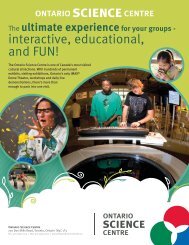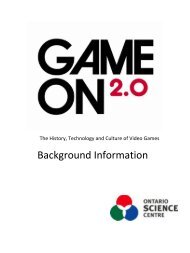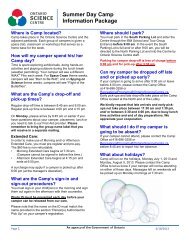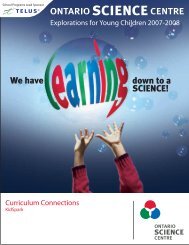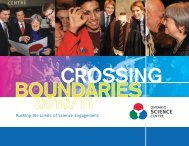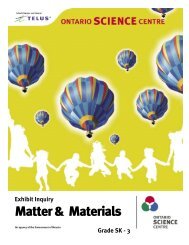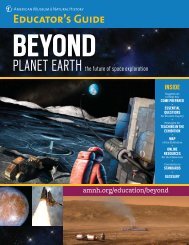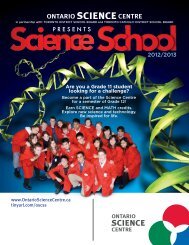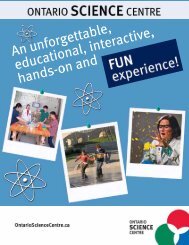STAR TREK LIVE! - Ontario Science Centre
STAR TREK LIVE! - Ontario Science Centre
STAR TREK LIVE! - Ontario Science Centre
Create successful ePaper yourself
Turn your PDF publications into a flip-book with our unique Google optimized e-Paper software.
Teachers Resource Manual<br />
Additional Extension Ideas<br />
MATH<br />
• Have students create a scaled version of the<br />
solar system across a wall in the classroom.<br />
They can use paper or any other materials so<br />
long as the planets and the distance between<br />
them is to scale. Divide the class into groups<br />
of three. Assign NASA space missions to each<br />
group. A space mission is a project to send a<br />
probe or other object into space. This probe<br />
collects data about a particular part of the<br />
universe and sends it back to Earth. Have each<br />
group research and plot their mission’s space<br />
travels on the class solar system—trajectories,<br />
asteroids, and visited planets and moons.<br />
• Use Star Trek characters and places to create<br />
math word games (See www.startrek.com<br />
library section in Characters and Places). For<br />
example, Captain Kirk beamed down to the<br />
planet Deltazoid with a landing party of four<br />
people. They met the planet’s ruling council,<br />
and seven council members asked to visit his<br />
starship. How many people beamed up to the<br />
starship?<br />
• Have students research reliable, spacerelated<br />
sites such as NASA and create a space<br />
phenomena calendar. For example, mark the<br />
days of the year when the next meteor shower<br />
happens.<br />
LANGUAGE ARTS<br />
• Have students write an advertisement to hire<br />
an astronaut for a new mission. They should<br />
list the qualifications required.<br />
• Have the students imagine that they are<br />
world-famous astronauts who are about to<br />
participate in a rocket launch and go on a<br />
space mission. Have them write a newspaper<br />
article in which they are interviewed about<br />
their training and expectations for space travel.<br />
ART<br />
• Have students design a spacecraft and build a<br />
three-dimensional (3-D) model using recycled<br />
objects.<br />
• Have students act like clothing designers.<br />
Instruct them to design and draw a flight<br />
suit that is protective material, comfortable<br />
to wear, suitable for astronaut activities, and<br />
creative (tip: Velcro is helpful to keep things<br />
like pens and notepads from floating away).<br />
• Astronauts on every space shuttle mission<br />
design their own patches. Have students work<br />
in small groups to design patches for their future<br />
space shuttle missions. Each patch should<br />
include a mission number, date, astronaut’s<br />
name, and mission highlights.<br />
• Have students research how astronomers add<br />
color to space phenomena images. Give them<br />
black-and-white images to colorize based on<br />
their theories.<br />
• Star Trek crews have the ability to travel from<br />
star to star. What if you could travel through<br />
space? Have students write a ballad that<br />
describes their experiences.<br />
• Living on the International Space Station (ISS)<br />
is the closest experience we have to living<br />
aboard the Enterprise. Have students research<br />
life aboard the ISS and write a series of diary<br />
entries describing their findings.<br />
Additional Extension Ideas<br />
33




